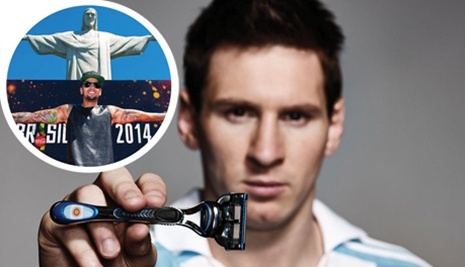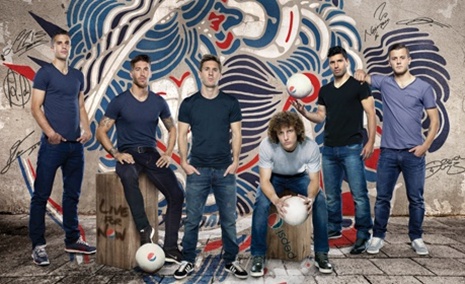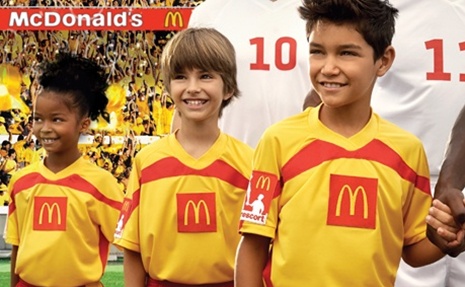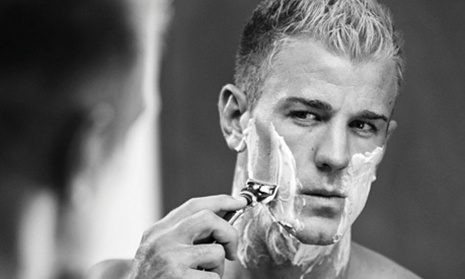What’s your World Cup marketing strategy?
Brands have the most sophisticated and hi-tech gameplans yet for the tournament.
Above: Lubricant brand and World Cup sponsor Castrol last month signed up Brazilian football star Neymar to front its marketing activity during the tournament
The countdown has begun. Today (4 March) marks 100 days until the start of the Fifa World Cup in Brazil, and anticipation is building. As domestic football seasons around the world enter their final stages, fans are starting to look ahead to the big kick-off in Sao Paulo on 12 June and the delights of a soccer-filled summer. Now is a critical time for brands to plan their match strategies and score goals against competitors, with Budweiser owner and Fifa sponsor AB InBev announcing a significant increase in its marketing spend[1] just last week.
Brazil is the home of creativity, carnivals and sunshine, as well as the most successful team in World Cup history, so brands should have plenty to work with. Non-sponsors will also have more leeway than during the Olympics thanks to the ubiquitous nature of football, so marketers have everything to play for to capture the imaginations of fans across multiple channels.
Despite the huge sums involved in World Cup sponsorships - Fifa raised more than $1bn from global brands in 2010 - questions remain about how best to derive maximum marketing value from the tournament. The World Cup is a four-week frenzy when brands fight for consumers’ attention, so achieving cut-through during the event is a difficult task for all marketers.
Tourism spend
The Brazilian Institute of Tourism forecasts that visitors to the event will spend over $11bn (£6.6bn) in the country: more than 20 times the earnings of South Africa during the last World Cup. The cost of media buying is set to soar too, with Brazil’s Globo TV network due to make $600m from regular ad slots booked by sponsors during its World Cup coverage.
We know second screening can play an important part in live TV events… It is also an important part of a live tournament such as the World Cup
Fifa, meanwhile, predicts that it will collect around $4bn for its own coffers from Brazil 2014, with the majority coming from TV rights and around a third from sponsorship and marketing. This would be an increase on the 2010 World Cup, when it raised $3.7bn in total and $1.1bn from sponsorship.
Many sponsors apparently feel they are getting value for money. In January, Visa became the fifth Fifa sponsor to extend its deal and commit to the 2018 and 2022 World Cups, joining Adidas[2] , Coca-Cola[3] , Hyundai-Kia and AB InBev[4] .
Consumers expect honesty, authenticity and engaging content from brands, but not all sponsors are hitting the right spot. Last week the Brazilian tourist board forced Adidas to stop selling World Cup t-shirts in the US that featured suggestive images of women. Brazil’s Ministry of Women’s Affairs said the shirts exposed women to the “barbarism” of sexual predators.
Adidas will hope to move on from this episode with its upcoming World Cup campaign. This will undoubtedly draw on the sportswear brand’s huge roster of football ambassadors including Lionel Messi, Philipp Lahm and Iker Casillas. Adidas, which recently extended its Fifa partnership until 2030, has predicted that sales from its football division will break the €2bn (£1.6bn) barrier for the first time in 2014 as a result of the World Cup.
Brand awareness
Other sponsors are less focused on growing sales and more concerned with raising brand awareness. Irish poultry brand Moy Park sits within Fifa’s second sponsorship tier alongside brands such as McDonald’s and Budweiser, as a result of a deal signed by its Brazilian parent company Marfrig to sponsor the 2010 and 2014 Word Cups.

Gillette’s new campaign features Messi, while Coke is using US pop star David Correy
While Moy Park lacks the same profile as many of its fellow global sponsors, director of brand marketing Andrew Nethercott believes the sponsorship is an important tool in growing awareness and product distribution in its key European market. “It shows we are serious about developing the Moy Park brand into a leading player and that we want to bring a bit of excitement into the poultry aisle, which is not the most exciting place to shop,” he says.
The majority of the company’s business in Europe comes from supplying poultry for retailers’ own-label products, though Moy Park branded products are well known in Ireland. It aims to increase the penetration of the brand in the UK with on-pack promotions offering shoppers the chance to win trips to the World Cup, as well as strengthen its retail partnerships through corporate hospitality.
“Those key [retail] customers that travel out with us will get an opportunity to look at the wider Marfrig business and the supply chain in Brazil,” notes Nethercott.
Castrol, the industrial and automotive lubricants brand, will similarly use the World Cup to raise awareness and build relationships with its business clients. Last month, it signed Brazilian football star Neymar to front its World Cup activity, adding to previous partnerships with stars such as Cristiano Ronaldo and Cafu. Castrol aims to create a clear association with the sport and engage football fans and clients around the concept of high performance.
“Neymar demands the best performance from himself in every game he plays, just as Castrol demands the best performance from our oils every time the engine starts,” says AS Ramchander, vice-president of global marketing at Castrol.
Delivering cut-through in a cluttered environment relies on quality memorable creative and driving a real connection with consumers
Brazilian beats
Beyond simply signing up footballers, brands are turning to more sophisticated forms of content creation to engage fans, with some sponsors putting music at the heart of their campaigns. Brazil is synonymous with carnival drum beats and dancing and this theme will run throughout the tournament, including during the opening and closing ceremonies. Fifa’s tagline for the World Cup is ‘All in one rhythm’.
Coca-Cola had success during the London Olympics in 2012 by harnessing music in its Move to the Beat campaign, which featured pop stars such as Mark Ronson and Katy B, claiming that it had more than 25 million views. The soft drinks brand is pursuing a similar tactic for this year’s World Cup by launching an anthem called The World is Ours.
To promote the song, performed by X-Factor USA finalist David Correy, Coca-Cola is inviting consumers on its social media channels to submit video clips that show their ‘moments of happiness’. The brand has partnered with creative collaboration platform Talenthouse to select a minimum of 20 winning clips for the final music video, which is set for release next month.
Music is also an obvious fit for Fifa partner Sony. Last year the brand launched a similar crowdsourcing contest SuperSong in which it asked aspiring musicians to submit videos of their original songs. The winning entry was selected earlier this year and will be performed by Puerto Rican pop star Ricky Martin for Sony’s official soundtrack for the tournament.
The campaign is designed to provide additional content across social media channels and emphasise the brand’s values and products, rather than just its football sponsorship. The SuperSong Facebook[5] page currently has more than 120,000 fans. “We hope Sony’s unique combination of technology, TV content production and entertainment expertise will provide an entirely new, interactive World Cup experience,” says Soichi Kawachi, vice-president in charge of brand at Sony.
Sponsors are in the box seats, but there are plenty of opportunities for other brands to leverage the World Cup too. While Locog, the organiser of the 2012 Olympic Games, imposed tight restrictions against non-sponsors that sought to associate themselves with the Games, sanctions are less of a concern for brands planning campaigns around the World Cup. Non-sponsors can partner with a wide range of football teams and properties provided that they don’t break Fifa rules by using World Cup logos, for example.

Pepsi’s 19-strong ‘football super squad’ including Lionel Messi and Sergio Agiiero will be its brand ambassadors during the 2014 Fifa World Cup
Pepsi[6] has already revealed how it plans to take on Coca-Cola this summer. In January, the brand unveiled a 19-strong “football super squad” for 2014 that includes longstanding Pepsi brand ambassadors such as Sergio Aguero and new faces like Germany striker Mario Gomez.
The ‘squad’ was announced on social media as a teaser to Pepsi’s upcoming football activity this year. This will include a global TV campaign during the World Cup and special commemorative packaging in the lead-up to the event, as well as digital content featuring the players.
Men’s shaving brand Gillette, meanwhile, has also begun its build-up to the World Cup with the launch last month of its ‘inner steel’ campaign on YouTube, featuring brand ambassadors Lionel Messi and Roger Federer. The video, which at time of publication had been viewed more than 16 million times, introduces viewers to Gillette’s new special edition range of razors. These are designed in the different colours of footballing nations around the world.
Such activations allow the brand to flirt with the themes and imagery of the World Cup without straying onto Fifa territory. Gillette has a long association with football and was a World Cup sponsor for 30 years until 2006.
“Delivering cut through in a cluttered environment relies on quality, memorable creative and sufficient reach – but more importantly on driving a real connection with the consumer,” says Jared Regan, Gillette brand manager at parent company P&G UK and Ireland. “The credibility Gillette carries in sports and sports marketing goes a long way.”
Advertising innovations
Both sponsors and non-sponsors will go into this World Cup with the most advanced advertising platforms of any previous tournament. ITV[7], which shares British broadcasting rights for the World Cup with the BBC, has claimed that it can “commercialise the full 90-minutes” of matches for brands by using second-screen devices and real-time advertising.
In addition to its flagship TV channel, viewers will be able to watch matches live via the ITV Player streaming service on PC, mobile and tablet, enabling brands to reach users on the move. The network is also developing a mobile responsive site for its World Cup content that will provide users with real-time updates.
“The site will incorporate a variety of content including pre-match analysis and interviews from our pundits as well as live match data and interactive polls,” says Stephen Poole, multi-platform group sales controller at ITV. “All of this adds up to lots of opportunities for brands.”
Poole says ITV is in talks with numerous brands regarding its more innovative ad formats for the World Cup. These include the live ads currently used by gambling brands during football broadcasts, second screen takeovers and broadcast adverts that incorporate the music discovery app Shazam. ITV also aims to replicate the success of its existing entertainment apps during the World Cup. Such apps often incorporate brands via interactive ads and games.
“We know that second screening can play an important part in many live TV events – just look at the success we have had with our companion apps for The X Factor and Britain’s Got Talent,” says Poole. “This is also an important part of a live tournament such as the World Cup.”

Technological advancements in outdoor media also present brands with opportunities to innovate this summer. Outdoor media agency Admedia reports that according to TGI figures, its pub and bar audience is 102 per cent more likely than the national average to download video content onto their phones and 77 per cent more likely to scan QR and NFC codes. The company manages the inventory of a number of pub chains including Yates’s, Slug and Lettuce and Rileys Sport Bars and is preparing to deliver a range of different ad solutions during the World Cup.
Last month, Prime Minister David Cameron called for an extension to pub opening hours during the World Cup to allow fans to watch England matches that kick-off late – a move that could present brands with further engagement opportunities. A final decision from the Home Office is pending.
Controversies and responsibilities
Although the World Cup is a big opportunity for marketers to innovate, there are inherent risks for brands too. The criticism levelled at sponsors during last month’s Winter Olympics in Sochi, Russia is indicative of the challenges that brands face when attaching themselves to events of huge political and cultural significance.
In the case of Sochi, the most controversial issue concerned the Russian government’s position on homosexuality and the rights of gay people in the country. Several sponsors found themselves in the line of fire on social media during the event. McDonald’s, for example, saw its #CheersToSochi hashtag ‘hijacked’ by gay rights campaigners on Twitter.
Ongoing social unrest in Brazil could present sponsors with further problems at the World Cup. Violent protests erupted in the country last year over a range of issues including poverty and political corruption, as well as the huge cost of hosting the World Cup. The demonstrations have continued into 2014, suggesting that disorder could break out during the tournament.
For brands the question is whether to distance themselves from such controversies, or engage with the issues directly and take a stand. In the case of Sochi, sponsors took the first course of action and issued statements that avoided specific comment on Russian policy in favour of their own positions on equality and human rights.
Rob Mason, managing director of sports and media business IMG Consulting International, believes that sponsors of major sporting events have always faced this dilemma. He argues that in most cases brands should avoid acting as the moral arbiters of wider issues and remember that they are ultimately “only sponsors”.
“I don’t think sponsorship is any more risky than it was before,” he says. “Brands go into major deals with their eyes reasonably wide open and know that things could happen that they need to be prepared for. If you’re willing to publicly comment [on an issue] and judge that wrong, your own reputation can be trashed in two seconds flat.”
Managing reputational harm is one of the many potential challenges that brands will have to overcome amid the World Cup hysteria this summer. But if marketers can align creative and engaging campaigns with smart PR, their rewards from Brazil could be huge.
Q&A

Jared Regan
UK and Ireland brand manager
Gillette
Marketing Week (MW): What are the main marketing channels that Gillette is using to engage football fans in the run-up to the World Cup?
Jared Regan (JR): First and foremost, we will be working with our retailers to create standout in-store theatre. We have some fantastic assets and imagery from our big name ambassadors like Joe Hart and Lionel Messi to attract interest from shoppers, create excitement in stores and drive sales.
We have invested in an array of creative assets featuring brand ambassadors and fans alike. This will play out across a multi-touchpoint campaign with traditional media driving mass awareness of our new special edition range of products and our suite of world class ambassadors further building on the already long-established association Gillette has with football. At the heart of our campaign will be digital engagement and social media that will showcase the fans themselves.
MW: Given the huge amount of marketing that occurs around the World Cup, how can Gillette ensure it stands out from the crowd with its own activations?
JR: Over the years, Gillette has been associated with athletes, teams and tournaments across all sports. Given this long standing history, including being an official sponsor of the Fifa World Cup for 30 years until 2006 and more recently an official Olympics partner, Gillette has became synonymous with sport.
The latest array of world class footballers such as Hart, Messi, Muller, Aguero, Falcao, Oscar and Chicharito join a long and prestigious list of past Gillette football ambassadors, which most famously included Beckham and Henry.
MW: Does the fact that Gillette is not a Fifa sponsor put certain restrictions on the brand’s marketing around the World Cup?
JR: We respect the rights, territories, exclusivity and access owned by official World Cup sponsors and accept the limitations being a non-partner places on us. But there is still great scope for the Gillette brand to be present and compelling with our message and our campaign in men’s lives around our shared love of the greatest game on earth. Excitement and anticipation is building for the summer and consumers are going to be engaged and receptive to content and communications from lots of brands and across lots of channels.
Social soccer
Social media has become a vital tool for sponsors aiming to engage with football fans at a deeper level than their advertising. Although Adidas has not yet revealed the details of its World Cup campaign, the brand has slowly been building up a social following around the tournament by harnessing its exclusive position as the official sportswear provider of the World Cup.
In 2012, Brazilian football fans selected the name Brazuca for the official World Cup ball following an online poll by Adidas. The brand has since continued to generate teaser content for fans via a Twitter feed dedicated to the ball itself (@brazuca). The feed currently has 112,000 followers.
Meanwhile, McDonald’s is also seeking to build excitement around its sponsorship of the World Cup via social media. The brand’s main franchise operator in Brazil, Arcos Dorados, is inviting consumers from around the world to tweet photos that depict their favourite moments at the fast food chain.
Arcos plans to use the photos in outdoor media campaigns across Latin America during the tournament. In addition, the company is inviting children to send pictures they have drawn about the World Cup for a chance to attend the finals and walk out onto the pitch holding the hands of one of the players at the start of a match.
“Our main concern is to ensure that people can live the World Cup spirit through McDonald’s and relate the brand to this world party,” says Arcos Dorados vice-president of marketing Raul Mandia.
Other sponsors aim to build on their experience of the 2010 World Cup in order to provide more engaging content on social media. Hyundai’s UK marketing director Andrew Cullis says that while the brand used social channels at the last World Cup for competitions and ticket giveaways, it plans to “take this to another level” this summer by focusing on content creation.
“Football fans will watch any content so long as it’s good – they don’t care who it’s by,” he suggests. “We’re targeting armchair football fans who love the game but don’t go to matches anymore because of family commitments or whatever else. The atmosphere in Brazil will be incredible and we want to bring some of that feeling to the UK.”
Fifa sponsorship
Fifa’s commercial deals are broken down into three tiers, though after this year’s World Cup the exact arrangements will change. At present, six brands are given the most prominence as Fifa partners (Adidas, Coca-Cola, Emirates, Hyundai-Kia Motors, Sony and Visa). Beneath that is a second category of eight international World Cup sponsors, including Johnson & Johnson, Brazilian telco Oi and solar panel company Yingli Solar.
The third tier is made up of six domestic companies that hold marketing rights within the host nation. Under Fifa plans to increase its partners and boost revenues, this third group is to be replaced for the 2018 World Cup with 20 ‘regional supporters’ split across five continents.
Tips for non-sponsors
Be authentic Non-sponsors should ensure there is a credible and compelling reason to associate themselves with the World Cup – rather than just jumping on a bandwagon. Gadget maker Garmin ran an inventive campaign during the last World Cup by using ad space at motorway service areas to promote a sat nav model that turned into a television when stationary. The campaign, supported by outdoor media agency Admedia, was targeted at people who were desperate to watch matches while on long journeys.
Real-time reactions All brands can participate in the World Cup through their social media activity, though bandwagon-jumping is again best avoided. Instead non-sponsors should think about how they can use on-pitch incidents to create compelling content in real-time. Specsavers is one brand that has used sporting controversies to push its ‘Should’ve gone to Specsavers’ tagline to humourous effect. Marketers should think carefully about where their brands fit into the World Cup mix.
Rival campaigns Brands that plan to go up against a Fifa partner and direct rival must ensure they have the marketing firepower to carry the fight. Pepsi is making a significant investment in its new ‘football super squad’ of brand ambassadors as it looks to challenge Coke, but other non-sponsors may prefer to sidestep the World Cup in their marketing and avoid direct clashes with sponsors.
New technology The excitement around a big sporting event like the World Cup often means that consumers are more open to experimentation and innovation from brands. It’s not surprising then that ITV is planning to trial a number of new ad formats during this summer’s tournament, including second screen takeovers and real-time adverts. Brands should consider whether they want to be among the first to test out these new opportunities.
References
- ^ Budweiser owner and Fifa sponsor AB InBev announcing a significant increase in its marketing spend (www.marketingweek.co.uk)
- ^ Adidas (www.marketingweek.co.uk)
- ^ Coca-Cola (www.marketingweek.co.uk)
- ^ AB InBev (www.marketingweek.co.uk)
- ^ Facebook (www.marketingweek.co.uk)
- ^ Pepsi (www.marketingweek.co.uk)
- ^ ITV (www.marketingweek.co.uk)









